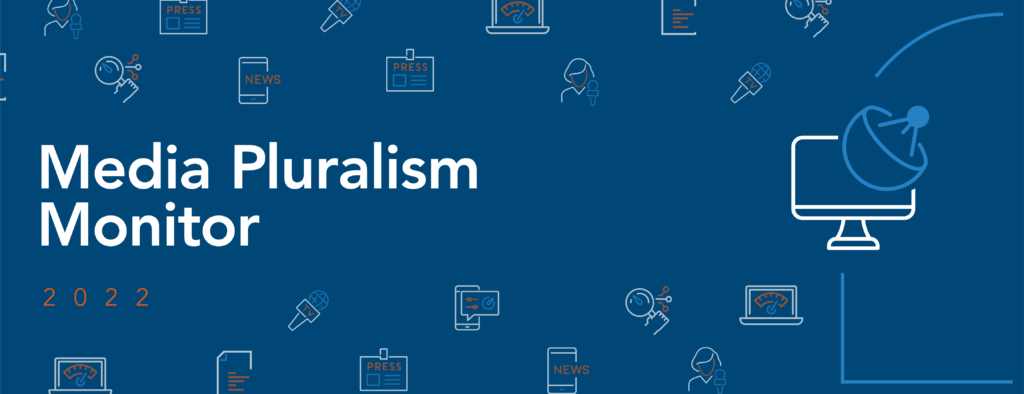
Pluralism of the media constitutes one of the essential pillars of democracy. Freedom of expression and freedom and pluralism of the media are enshrined in the Charter of Fundamental Rights of the European Union (Article 11), and their protection is underpinned by Article 10 of the European Convention on Human Rights. This report presents the results and the methodology of the Media Pluralism Monitor 2022, based on its implementation in 32 countries (27 EU Member States and 5 candidate countries) for the year 2021. The Media Pluralism Monitor (MPM) is a tool that is geared toward assessing the risks to media pluralism in both EU Member States and in candidate countries. Since 2013/2014, it has been implemented on a regular basis by the Centre for Media Pluralism and Media Freedom, and on a yearly basis since 2020. This tool is based on a holistic perspective, taking into account the legal, political economic variables that are relevant in analysing the levels of plurality in media systems in a democratic society.
Fundamental Protection
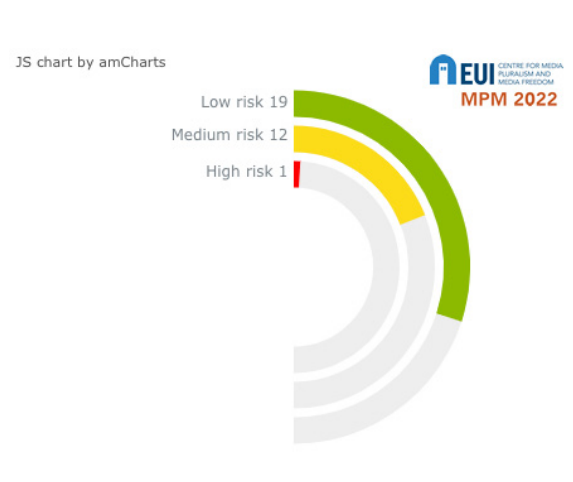
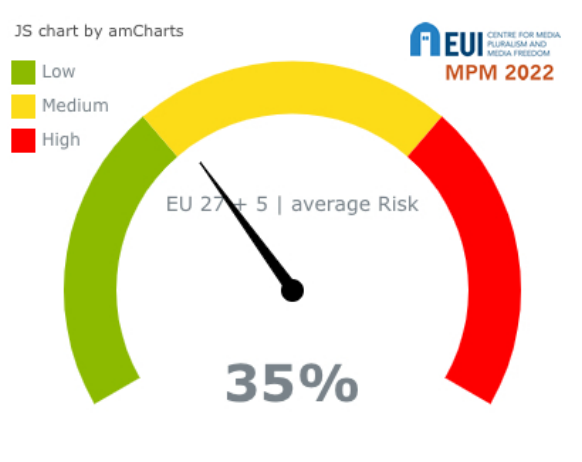
The Fundamental Protection area of the MPM considers the necessary preconditions for media pluralism and freedom, namely, the existence of effective regulatory safeguards to protect the freedom of expression and the right to seek, receive and impart information; favourable conditions for the free and independent conduct of journalistic work; independent and effective media authorities; and the universal reach of both traditional media and access to the Internet. As in the previous round of the MPM, the Fundamental Protection area also focuses on the challenges that are posed by the online environment to the plurality of the media landscape. It thus assesses the protection of freedom of expression online, data protection online, the safety of journalists online, the levels of Internet connectivity, and the implementation of European net neutrality obligations.
The general risk score for the Fundamental Protection area in the MPM 2022 has remained at 35%, which is in the medium-risk range, the same risk score as last year. Similarly to the previous round of the MPM, the majority of the countries analysed scored as being a low risk, and, in relation to the Fundamental Protection area, 19 of the 32, namely, Austria, Belgium, Cyprus, Denmark, Estonia, Finland, Germany, Ireland, Italy, Latvia, Lithuania, Luxembourg, Malta, Netherlands, Portugal, The Republic of North Macedonia, Slovakia, Sweden, and The Czech Republic. The sole difference, in comparison to the MPM 2021, is that Italy has joined the low risk group in 2022. The countries which scored a medium risk are 12 in number, and they include Albania, Bulgaria, Croatia, France, Greece, Hungary, Montenegro, Poland, Romania, Serbia, Slovenia and Spain. As in the MPM2021, the only country which scored as a high risk is Turkey. The Fundamental Protection area shows a stable trend, in comparison to the MPM2021. Indeed, three out of the five indicators show the same, or a one percentage point difference, in the general average risk. This is the case of the indicator on the ‘Protection of freedom of expression’, ‘Independence and effectiveness of the media authority’, and ‘Universal reach of traditional media and access to the Internet’. The indicator on the ‘Protection of the right to information’ shows a slight improvement of 3%, in comparison to the MPM2021, with four countries shifting from a medium risk to a low risk score, namely, Denmark, Luxembourg, Portugal and Sweden. This positive shift can be attributed to the transposition into national law, in 2021, of EU-Directive 2019/1937 on the protection of whistleblowers, as was the case in Denmark and in Sweden.
As in previous rounds of the MPM implementation, Turkey is the only country that scores as a high risk in Fundamental Protection, confirming a trend of deterioration in the protection of fundamental rights and values. Of particular concern is the still high number of imprisoned journalists in the country, coupled with a lack of independence among the judiciary, and abusive use of the criminal justice system, in particular, when it comes to limiting freedom of expression. The trend to the prosecution of writers, journalists and social media users for insulting President Erdogan has grown. Journalists have extensively been prosecuted and imprisoned on charges of terrorism, insulting public officials, and/or committing crimes against the State.
By contrast, the indicator on ‘Journalistic profession, standards and protection’ shows a slight deterioration of 3%, in comparison to the MPM2021, with two countries shifting from a low risk to a medium risk score, namely, Austria and The Republic of North Macedonia, and another two shifting from a medium risk to a high risk: Croatia and Greece. This negative shift, already seen in 2021, can be explained, amongst other things, by the absence of anti-SLAPP frameworks (‘strategic lawsuits against public participation frameworks). In effect, a growing number of SLAPPs was reported in various countries, such as Bulgaria, Croatia, Malta and Romania. For instance, some of the SLAPPs were also reported on the Council of Europe’s Platform for the Safety of Journalists. Likewise, the growing threats to the safety of journalists also contributed to the negative shift in relation to this indicator, as mentioned by some of the country reports (Seethaler & Beaufort, 2022; Trpevska & Micevski, 2022).
Indeed, while, in 2020, no journalist was murdered in the EU, the Member and candidate countries, in 2021, three journalists were killed. In April 2021, the Greek journalist, Giorgos Karaivaz, was shot dead outside his house (Papadopoulou, 2022) and in July 2021, the famous Dutch journalist, Peter R. de Vries, died after a shooting in the evening of 6 July, while walking away from a television studio in central Amsterdam. In March 2021, the Turkish Radio presenter, Hazım Özsu, was shot in his house in Bursa. In Turkey, the indicator on the ‘Protection of Freedom of Expression’ has shown a slight improvement, decreasing from 95% in MPM2021 to 87% in MPM2022. This improvement is due to the decreasing number of imprisoned journalists in the country. However, the trend to punish professionals and news media which are critical of the government persists in Turkey. For instance, in 2021, 71 fines were imposed on TV networks critical of the government, whereas no fines were imposed on pro-government networks in the same period (Inceoglu et al., 2022).
Market Plurality
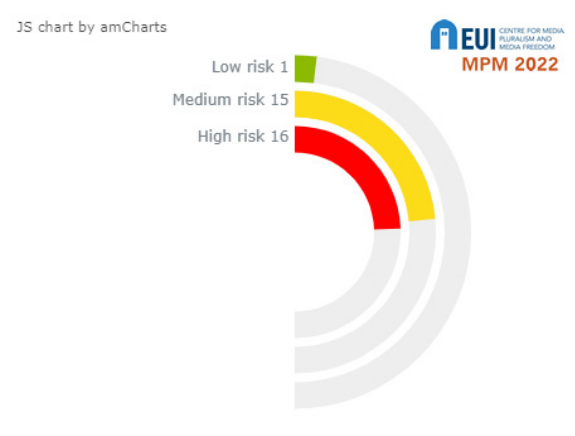

The Market Plurality area considers the economic dimension of media pluralism, assessing the risks that are related to the context in which market players operate. As in the other areas of MPM, the risks are evaluated taking into consideration the legal framework and its effectiveness, and quantitative economic variables. The players included in the assessment for this area are the media content providers and other actors that, even though they do not produce original news content, have a relevant role and a substantial impact on the distribution of the media content, such as digital intermediaries. Threats to market plurality may emerge from the lack of transparency in media ownership; from highly concentrated markets, both on the production and on the distribution side; from the poor economic sustainability of the media industry and from the influence of commercial interests on editorial content. As in the previous MPM exercises, this area presents the highest level of risk across all the areas of the Monitor. The historical and structural factors that contribute to raising the risk to Market Plurality, such as a high concentration in the traditional media sectors, still characterise the European media market; indeed, the tendency to concentration has intensified across the years and is confirmed in the MPM2022 assessment. The market power of a few digital intermediaries also contributes to raising the risk, together with a reduction in the effectiveness of national legal anti-concentration frameworks that, when existent, are modelled on the legacy media environment. On a positive note, the year 2021 has been characterised by economic recovery in all the EU Member States after the first wave of the COVID-19 pandemic. This led to a decrease of the risk in the indicator that measures the economic sustainability of media production, from high to medium risk; nonetheless, it must be noticed that the improvement for this indicator is not very significant, from a quantitative point of view, and is not generalised to all the media sectors. In most countries, media revenues are still not back to the pre-COVID-19 level. All these phenomena have impacted upon the independence of editorial content from commercial and/or owners’ influence. The result of these different trends is an average risk of 66% for the Market Plurality area in MPM2022, which has declined from 69% (high risk) in MPM2021. In this area, there is only one country at low risk (Germany, with 30%), 15 countries at medium risk (Austria, Belgium, Croatia, Denmark, Estonia, Finland, France, Italy, Latvia, Lithuania, Luxembourg, Portugal, Sweden, The Netherlands, The Republic of North Macedonia), and 16 at high risk (Albania, Bulgaria, Cyprus, Greece, Ireland, Malta, Montenegro, Hungary, Poland, Romania, Serbia, Slovakia, Slovenia, Spain, The Czech Republic, Turkey). It is worth mentioning that many countries at medium risk are close to the border of high risk, and that three countries exceed the risk score of 80%, therefore presenting a very high level of risk.
For this area, two indicators are, on average, at a very high risk level, and they assess News media concentration and Online platforms concentration and competition enforcement. The ownership concentration risk score is slightly increased in comparison with the MPM2021, due to a growing tendency in the traditional media industry to merge and consolidate; the online advertising market, which also continues to be highly concentrated, whereas the slight decrease in the risk score for the indicator on the digital platforms is to be explained by some signals of an evolving situation in the regulation and competition tools in some of the Member States. The indicator on Media viability – assessing the economic sustainability of media, in terms of revenues, employment and resilience, and registering also the eventual contribution by public support – shows a sizable decrease in the risk level: it is now, on average, at 56% (medium risk), whereas it was at 69% (high risk) in the MPM2021. The improvement in revenues did not come, in the majority of cases, with an improvement in the working conditions of the journalists. The indicator on Transparency of media ownership is at medium risk (55%), improving from the 58% seen in the previous assessment, because of legislative initiatives, and the establishment of media ownership registers in some Member States (following the transposition of the Anti-money Laundering Directive V, EU 2018/843). Nonetheless, the transparency of ultimate and beneficial ownership and effective access by the public to the relevant information remain matters of concern in many Member States. The indicator on Commercial & owner influence over editorial content registered a slight increase, from 62% to 63%, and so is still at medium risk, signalling that the high concentration of media ownership, often intertwined with other economic and political interests, as well as the persistent risks in media viability, contribute to the menacing of journalistic independence.
Political Independence
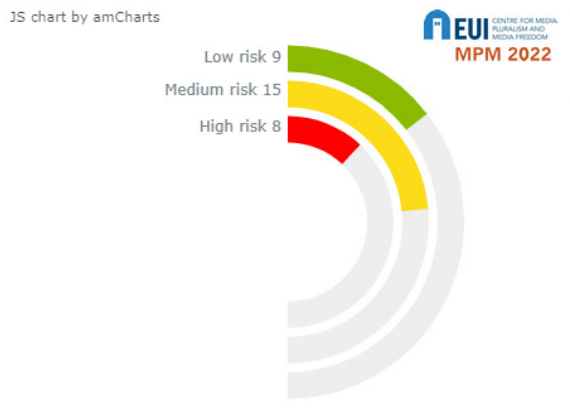
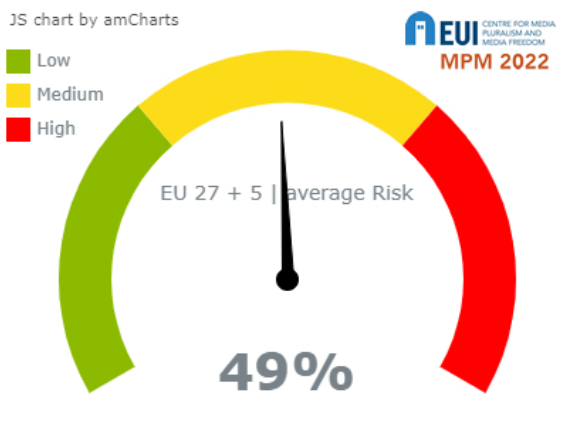
The Political Independence area is designed to evaluate the risks of the politicisation of the distribution of resources to the media; political interference with media organisations and news-making; and, especially, political interference with the public service media. Further, it looks at the availability of safeguards against manipulative practices in political advertising in the audiovisual media and on online platforms (including the social media). Political pluralism, as a potential for actively representing the diversity of the political spectrum and of ideological views in the media and other relevant platforms, is one of the crucial conditions for democratic citizenship. The Political Independence area, on average, continues to show a medium risk (49%), one percentage point higher than last year, indicating that no significant progress has been achieved in ensuring higher levels of political independence and political pluralism in the media across the European Union and in the candidate countries. There are eight countries that score high risk on Political Independence, three of which are EU candidates (Albania, Serbia, and Turkey) and the other five belong to the group of more recent EU Member States that joined in 2004 (Hungary, Malta, Poland, Slovenia) and 2007 (Bulgaria). On the other end of the scale, nine countries are found to be at low risk (Belgium, Denmark, Estonia, France, Germany, Ireland, Portugal, Sweden, and The Netherlands). The largest number of countries, namely, 15, register a medium risk.
It is of particular concern that Editorial autonomy, as one of the key guarantees of journalistic freedom, and as a protection against undue external interference in the editorial newsmaking process, continues to be the indicator with the highest risk score in this area, in the upper medium risk band. In the vast majority of the countries encompassed by the MPM2022 there are no efficient mechanisms to protect editorial autonomy. This stands as a growing challenge in a context where the media struggle to survive, and thus experiment with business models and new business practices, which are often blurring the line between the news and advertising, or which rely more on public aid and government subsidies. Furthermore, the MPM2022 findings show that, in many countries, some of the major media organisations, in particular, newspapers and the audiovisual sector, are under political control related to ownership, and in half of the countries there is evidence that the appointments and dismissals of public service media management are, to some extent, politicised.
The indicator Audiovisual media, online platforms and elections continues to show the lowest risk score in this area, which is mainly due to the fact that political advertising in audiovisual media, especially in the public service media, is strongly regulated across Europe, and so is the impartiality of PSMs’ reporting during electoral campaigns. However, the online environment draws a much more gloomy picture, as many countries remain without adequate rules and the consideration of risks that are related to political advertising online, including that on social media platforms. Instruments, like those that ensure transparency in political advertising during election campaigns in the audiovisual media, are not common in the online sphere, where different possibilities are offered, various actors engage in placing political ads, and different techniques are used to influence political opinions.
Social Inclusiveness
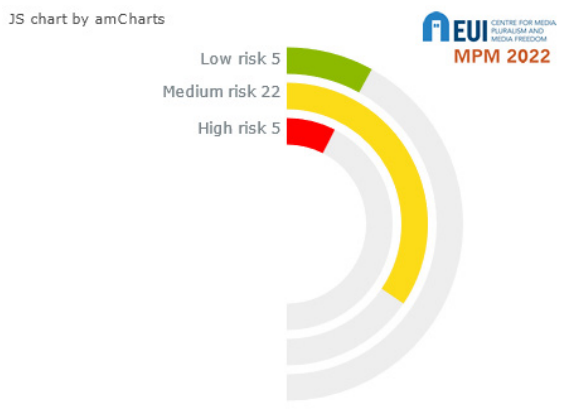

With an average risk that is estimated at 54%, the Social Inclusiveness area shows a slight improvement (two percentage points lower) in comparison with the previous edition of the MPM. Of 32 countries, 22 are in the medium risk band (Albania, Austria, Belgium, Croatia, Estonia, Finland, Greece, Hungary, Ireland, Italy, Latvia, Lithuania, Luxembourg, Malta, Poland, Portugal, Serbia, Slovakia, Spain, Slovenia, The Czech Republic, The Republic of North Macedonia); five countries are associated with a high risk (Bulgaria, Cyprus, Montenegro, Romania, and Turkey), and five countries are in the low-risk band (Denmark, France, Germany, Sweden, and The Netherlands).
The risk associated with three of the Social Inclusiveness indicators – Access to media for local/regional communities and for community media, Access to media for women and Media literacy – has decreased. In the context of the COVID-19 pandemic, some governments have provided some ad hoc subsidies to help local and regional media. The “infodemic” linked to the pandemic has also highlighted the need to reinforce media literacy policies in order to prevent the spreading of misinformation. The indicator Access to media for women remains in the upper fringe of the medium-score band for all of the countries, despite a significant improvement in comparison with the previous edition of the MPM (four percentage points lower when measuring the risk for the EU Member States, as well as when measuring the risk for all of the countries). In almost half of the countries studied, there is no comprehensive gender policy in the public service media and women are still under-represented in management positions.
The overall risk that is associated with the indicator Protection against illegal and harmful speech remains stable within the EU Member States at 58%, and almost stable at 60% for all of the countries (one percentage point lower, when compared to the previous edition of the MPM).
Media pluralism in a digital environment
In the Fundamental Protection area, the average score of the digital variables is in the same range as the overall score, medium risk, but is three percentage points higher, at 38%. Although comparable to the overall score of the offline Fundamental protection area, the slightly higher score in the digital environment can be attributed to the increasing risk to journalists’ safety online, as described in some of the country reports (Papadopoulou, 2022; Holznagel & Kalbhenn, 2022; Kies et al., 2022), including ransomware attacks on news media websites (Cádima et al., 2022) and the use of spyware technologies against journalists (Bátorfy et al., 2022).
In the Market Plurality area the average score of the digital variables is in line with the overall score (65% vs. 66%). This is because the main drivers of risk in this area are in the indicators on media concentration, and those indicators are at high risk in the digital environment too. The assessment, in this case, is derived mostly from the market dominance of digital platforms, whereas, in the field of the digital news media, the evaluation is limited by the lack of consistent and transparent data. As regards the Transparency of media ownership, the digital risk is higher in comparison with the overall risk, as, in most countries, the obligations for transparency do not include the digital media, or they do not cover them effectively (for example, in the case in which those media are cross-border outlets). On the contrary, a lower level of digital risk emerges in the indicator on media viability, as the digital media are more competitive in the tight conditions of the media market, and, in some countries, the signals of the resilience of alternative business models are growing. To conclude, the commercial and owner influence over editorial content in the digital media shows a lower risk.
In the Political Independence area, the average score of the digital variables is slightly higher than the overall score, but is still in the same medium risk range. This elevated risk is mainly a reflection of the lack of regulation in the vast majority of the countries under analysis, especially regulation that will ensure the transparency of political advertising on online platforms during electoral campaigns. Furthermore, in more than two thirds of the countries, the local experts have assessed that online platforms and social media do not take sufficient steps to ensure the transparency of online political advertising, and in almost all of the countries, the political parties and the candidates are not fully transparent about the spending and techniques that are used in social media political campaigns. The digital dimension recorded additional risks in relation to a lack of effective regulation that adequately covers the online public service mission of the PSMs, while considering its potential implications for commercial media actors. Meanwhile, a positive note comes from the political independence of the digital native news media sector. Although concerns emerge in several countries in relation to a lack of transparency in the ownership data in relation to the digital native media, these outlets are, on average, still less susceptible to political control, if compared to traditional media, in particular, the newspapers and audiovisual media.
In the area of Social Inclusiveness, the risk associated with the digital indicator Protection against illegal and harmful speech remains stable within the EU Member States, at 58%, and is almost stable, at 60%, for all of the countries (one percentage point lower, if compared to the previous edition). However, a closer look at the two sub-indicators that compose the Protection against illegal and harmful speech show that the risk associated with the sub-indicator Protection against disinformation has decreased from 61% for the EU Member States to 58%, and from 65% to 59% for all of the countries, while the risk associated with the sub-indicator Protection against hate speech has increased from 58% to 60% for the EU Member States, and from 58% to 63% for all countries. On the one hand, the evolution of the risk level in the sub-indicator Protection against disinformation may be justified by the changes in the questionnaire. Some additional variables were added to better comprehend the different risks that are linked to disinformation (see Annexe 1). On the other hand, the increased risk that is linked to the sub-indicator Protection against hate speech is linked to the problematic absence of data in many countries (see Annexe 1). The impact of online disinformation is assessed as high in 15 countries (Austria, Bulgaria, Germany, Greece, Hungary, Latvia, Luxembourg, Romania, Serbia, Slovakia, Slovenia, Spain, The Czech Republic, The Republic of North Macedonia, and Turkey). In only two countries is the impact and spread of disinformation limited, leading to a low risk evaluation: Belgium and Denmark.
General Ranking
Starting from this MPM2022 implementation, the CMPF has decided to introduce the general ranking of the countries, as an additional element of transparency in the reporting. In this general ranking the countries are presented clustered into five levels of risk. This ranking provides a more nuanced visualisation of the results, based on which only Germany is very low risk; Turkey scores at very high risk, and Malta, Montenegro, Romania, Greece, Serbia, Slovenia, Bulgaria, Hungary, Poland and Albania are flagged as high risk countries. This five levels classification is also a test for the CMPF to evaluate the need and feasibility of operating a transition to an even more granular questionnaire and the consequent assessment of the risks. The average general risk score is 51%, which is also the percentage obtained by Italy, which ranks 16th at the exact middle of the scale of the analysed countries.
